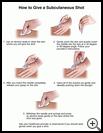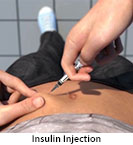
Diabetes: Types and Activity of Insulin
________________________________________________________________________
KEY POINTS
- Insulin may be used to control blood (sugar) glucose if your child has diabetes.
- The main types of insulin are rapid acting, intermediate-acting, long-acting, and pre-mixed. Your healthcare provider may prescribe a combination of different types of insulin to treat your child’s diabetes and to match your child’s eating schedule and lifestyle.
- Make sure you know how and when your child needs to take the medicine. Your child should not take more or less than he or she is supposed to take.
- Ask your healthcare provider or pharmacist what side effects the medicine may cause, and what you should do if your child has side effects.
________________________________________________________________________
What is insulin used for?
Insulin may be used to treat diabetes by controlling blood (sugar) glucose levels. It is a hormone normally made by the pancreas, which is an organ in your upper belly. Your body uses insulin to help move glucose from the blood into the cells, where it is used for energy.
Children with diabetes have problems with the way insulin is used in their bodies. Because of these problems, glucose cannot get into the cells. Instead, it stays in the blood. Too much glucose in the blood can damage the blood vessels and organs.
- If your child has type 1 diabetes, he does not make insulin and needs to take insulin shots.
- If your child has type 2 diabetes, his body may make insulin, but not enough, or his body may not be able to use insulin well. Your child may be able to control his blood glucose levels through a mix of healthy food choices, physical activity, and weight loss. And your child may take medicines by mouth to help his body make more insulin or to use the insulin he does make. In some cases, your child may need to take insulin.
Your child needs the right kind of insulin at the right times during the day. The amount and kind of insulin is very important. If your child takes too much insulin or takes it at the wrong time, your child could have a serious or life-threatening low blood glucose reaction. If your child doesn't take enough insulin, or forgets a dose, his body will not be able to use food for energy, glucose from digested food will stay in the blood, and the blood glucose will be too high.
How does it work?
Your child’s body needs insulin to move glucose from the blood into the cells, where it is burned for energy. The body cannot turn glucose into energy without insulin. If insulin is not available, glucose from digested food builds up in the blood. Insulin controls high blood glucose but does not cure diabetes.
The main types of insulin are:
- Rapid acting insulin that starts to work in 10 to 20 minutes and lasts up to 4 hours
- Intermediate-acting insulin that starts to work in 1 to 3 hours and lasts up to 18 hours
- Long-acting insulin that starts to work in 1 to 2 hours and lasts 26 hours
- Pre-mixed insulin that is mix of insulin types
Your child's healthcare provider may prescribe a combination of different types of insulin to treat your child’s diabetes and to match your child's eating schedule and lifestyle.
Have your child continue to use insulin even if he feels well. Your child should not stop using insulin without talking to your child’s health care provider. Your child should not switch to another brand or type of insulin or change the dose of any type of insulin your child uses without talking to your child’s health care provider.
Insulin comes in vials, prefilled disposable dosing devices, and cartridges. The cartridges are designed to be placed in dosing pens. Be sure you know what type of container your child’s insulin comes in and what other supplies, such as needles, syringes, or pens, you child will need to take the medication. Make sure that the name and letter on your child’s insulin are exactly what your child’s healthcare provider prescribed.
What else do I need to know about this medicine?
- Follow the directions that come with your child’s medicine, including information about food. Make sure you know how and when your child needs to take the medicine. Your child should not take more or less than he or she is supposed to take.
- Try to get all of your child’s prescriptions filled at the same place. Your pharmacist can help make sure that all of your child’s medicines are safe to take together.
- Keep a list of your child’s medicines with you. List all of the prescription medicines, nonprescription medicines, supplements, natural remedies, and vitamins that your child takes. Tell all healthcare providers who treat your child about all of the products your child takes.
- Many medicines have side effects. A side effect is a symptom or problem that is caused by the medicine. Ask your healthcare provider or pharmacist what side effects the medicine may cause and what you should do if your child has side effects. This medication causes changes in your child’s blood glucose level. You and your child should know the symptoms of low and high blood glucose and what to do if your child has these symptoms.
- Talk to your child’s healthcare provider or pharmacist about where on the body to inject insulin. You or your child can inject your insulin in the stomach, upper arm, upper leg, or buttocks. Use a chart to keep track of the sites used.
- If you have any questions, ask your child’s healthcare provider or pharmacist for more information.
Last modified: 2017-01-28
Last reviewed: 2018-01-10



